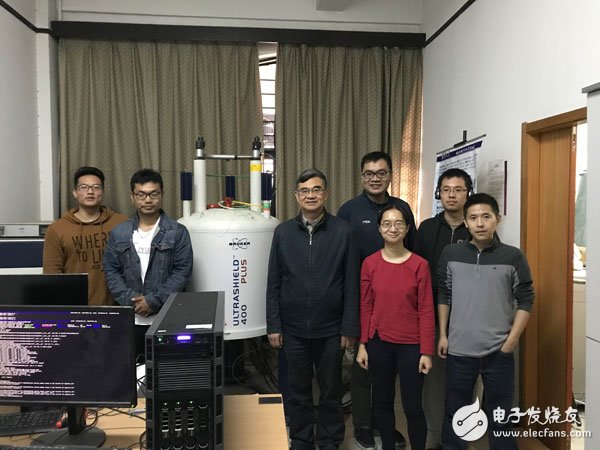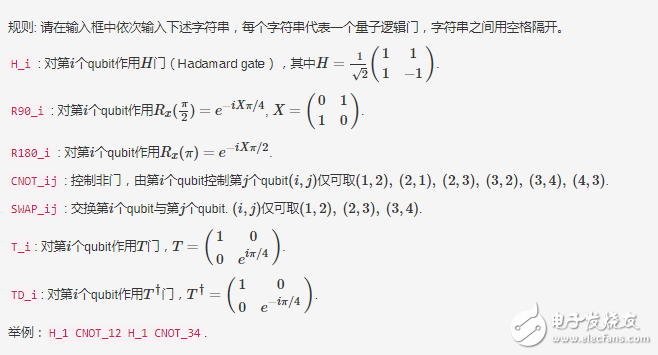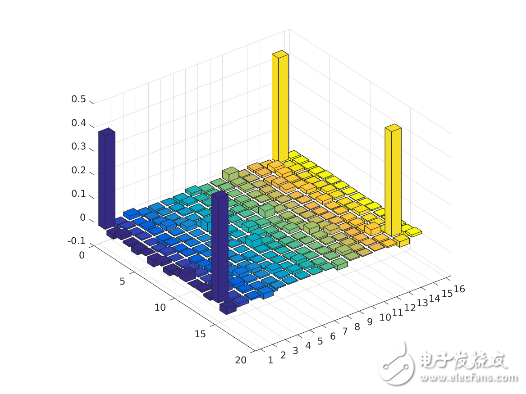Regardless of whether IBM or Google is exaggerating its progress in promoting quantum computing, from the perspective of IBM's introduction of quantum cloud services, it is clear that American researchers attach great importance to the practical application of quantum computing. Now our international quantum computing cloud platform is also on the line. The "Chinese version" of the quantum computing cloud platform was officially launched. Tsinghua University, Alibaba-China University of Science and Technology, and Yuanquan Quantum-China University of Science and Technology were released on the same day.
The quantum information revolution is accelerating. In 2016, IBM opened a cloud-based quantum computing platform to the public. After logging in, users can use a 5-qubit quantum computer for algorithm or experimental simulation. In March of this year, IBM announced plans. Established the industry's first commercial general-purpose quantum computing platform IBM Q.
In the field of quantum computing, competition at home and abroad is fierce. On October 10, Intel announced through its official website that the company produced a new chip containing 17 superconducting qubits, marking the quantum computing from the academic laboratory. Enter the semiconductor industry and move into the practical field.
Unlike IBM, the quantum computing cloud platform of Tsinghua University's research group is based on nuclear magnetic resonance quantum computers. What are the advantages and disadvantages of different quantum computer physics systems? We interviewed the NMR Quantum Computing Laboratory of the Department of Physics at Tsinghua University. They said, "We are very confident to disclose the control layer of our quantum cloud."

Part of the staff of the Nuclear Magnetic Resonance Quantum Computing Laboratory (Li Keren Xin Tao is responsible for the technology, the instructor is Long Guilu, Zeng Yi Yin Zhangqi Lu Dawei, Li Jun, Huang Shilin, Lu Sirui, etc.)
The Quantum Quantum Company, Alibaba and Academician Pan Jianwei from the Academician Team of the Chinese Academy of Sciences Guo Guangcan teamed up. A total of three teams released the quantum cloud computing platform on the same day. At the same time, we also published related papers on the pre-printed website. We have realized the connection between the network and the real nuclear magnetic resonance quantum information processing system. This is the first quantum cloud computing platform based on nuclear magnetic resonance in the world. Within 24 hours after the Chinese version is launched, the website has nearly 2000 unique IP access times. Nearly 150 registered users from different departments such as Tsinghua University, China University of Science and Technology, and the Ninth Institute, submitted online computing tasks more than 80 times, and also attracted the attention of international and Taiwan compatriots.
The quantum cloud platform contains only four qubits, but the logic gate fidelity is over 98%, and many complex logic gates can be completed. What representative computing tasks have been completed on this platform.
As one of the earliest physical platforms for quantum computing, NMR has developed many sophisticated quantum manipulation techniques and accumulated rich experience in quantum computing. It has made many important achievements in the field of quantum information and quantum simulation. The results, such as the spectrometer used for this cloud computing, have experimentally implemented the Grover algorithm with powerful search capability, high-fidelity coherent manipulation of 7 qubit systems, the world's first quantum quantum calculation, and quantum tunneling. Phenomena and quantum simulations such as plant photosynthesis. This quantum cloud platform is not only a quantum computing experience platform, but also a platform for quantum computing and quantum manipulation research. Users can use the quantum cloud platform to make innovative research and expect them to make outstanding results.


Quantum cloud usage rules and quantum cloud running results (example)
According to reports, quantum computing research has different levels, from the lowest physical layer, to the control layer, circuit layer, to the top algorithm. IBM's quantum cloud service is open to the circuit and algorithm layers in quantum computing. For researchers who want to make their own quantum computers, this service is not enough. So, how can you help your research on the control layer and the physical layer by building your own quantum cloud platform?
First of all, the service we build our own quantum cloud platform is completely open to the control layer. The so-called control layer, as we understand, the core is the design of the system control pulse. We need to consider time or energy optimization, reduce system errors, and resist environmental noise in the pulse design process. Nuclear magnetic resonance spectroscopy has accumulated a large amount of technology and experience in pulse design in the development of more than half a century. Especially in the past two decades, the quantum control method based on the nuclear magnetic resonance experimental platform tends to be more mature, and our team has brought together professional teams in this field. Therefore, we are very confident to disclose the control layer of our quantum cloud.
Automating the control plane of nuclear magnetic resonance quantum computing experiments will help improve our research efficiency. Further opening the control layer to the user, the user can learn from a more basic level and understand how the actual quantum computing system works. In fact, although different systems have various differences in details, they have many common points at the control level. We expect more peers to be interested in this and promote the application of NMR mature control methods. To other physical systems.

Connection of components in a quantum cloud
The general-purpose quantum computer has not yet come out. What are the characteristics of the various quantum computing prototypes? For example, the optical quantum computing prototype released in China was good at Bose sampling, and the prototype of the low-temperature superconducting system can be used to solve linear equations. Can you briefly introduce the nuclear magnetic quantum computer of your research group?
The main reason for the emergence of quantum computing prototypes of many different physical systems is that the practical quantum computers are not yet available, and there are many physical systems that can realize quantum computers, such as superconducting quantum systems, ion trap systems, and topological quantum. Computing systems, quantum optical systems, quantum dot systems, and of course our nuclear magnetic resonance systems. Manufacturing quantum computers has five requirements for systems. Different systems have their own advantages and disadvantages. They do not meet the five conditions that need to be met to build quantum computers. Now everyone is working hard to achieve quantum computers.
The quantum computing cloud service of IBM's new Jerry Chow team is said to be a superconducting quantum computing prototype with five qubits. What is the difference between your research group and the nuclear magnetic resonance quantum computer?
IBM launched the 5-bit superconducting quantum computing prototype in May last year, and in May this year they increased the record to 16 bits. After the introduction of IBM's quantum computing prototype, it has sparked a boom in academic circles. In the past year, research articles using IBM prototypes have sprung up, which has contributed to the development of quantum computing. In contrast, domestic online quantum services are lacking. In order to meet this need and development trend, we built this platform with our own system. Compared to IBM's prototype, since quantum computing is essentially implemented in two different physical systems, the natural difference is the difference between different systems. The superconducting system is a solid quantum system that excels at the expansion of the number of bits. Our NMR system is an ensemble quantum system that excels at achieving high precision operations. Another difference is of course that we only provide a four-bit quantum computing prototype.
Some people say that IBM's cloud service can be used for user-designed gate operations on the Internet, but users can't determine whether it's really done by taking the selected operation to the qubit, or just simulating it. If it is an analog implementation, is it limited?
IBM's five-qubit cloud computing service provided to online users, although we can't see its underlying layer, such as the control layer and physical layer you mentioned earlier, we believe that the task submitted by the user is implemented on the real qubit. Instead of a simple simulation implementation. The analog implementation here means that quantum computing is still actually simulated with classical computer operations. If this is the case, the user also gets the experience of quantum computing, but there are still some differences with the actual quantum computing. The quantum computing task in NMR quantum cloud computing is a real quantum computing system, and the calculation steps are the same as the large-scale practical quantum computers in the future. This is like saying that quantum cloud computing using classical computer simulation is equivalent to a military exercise in the military. Although it is not true quantum computing, it is also very meaningful. And a 4-bit nuclear magnetic resonance quantum cloud computing is equivalent to a real battle. Although only four soldiers participated, it was a real small battle.
We know that classical computers can also simulate quantum algorithms. So different quantum algorithms, such as the Shor algorithm for integer decomposition and cracking encryption, can be implemented natively on various quantum computers such as nuclear magnetic resonance computers. Is it better to implement more qubits for different quantum computer solutions?
In the past two decades, various quantum algorithms have been implemented on nuclear magnetic resonance quantum computers, including the Shor algorithm that first solved the large number decomposition problem and the Grover algorithm that solves the search problem. Although the implementation of these algorithms is still on a smaller system, usually no more than seven quantum bits, these studies show how quantum algorithms work on real quantum computers, deepening our practical implementation of algorithms, quantum The ability of the computer, as well as the improvement of the current stage of technology needs to be recognized. In addition, with the advancement of various quantum systems such as superconductors and ion traps, they can also implement various quantum algorithms on a small number of qubits.
What is the physical implementation of a better quantum algorithm? I think at least two criteria are needed: First, to achieve more qubit calculations, the current domestic and international competition is very fierce; the other needs to be seen at the same scale. In this case, how complex and fine the sequence of quantum gates can be manipulated, and the current nuclear magnetic resonance experimental platform still has certain advantages at this point. In order to realize practical quantum computers, the most important point is to be able to achieve quantum error correction, or fault-tolerant quantum computing, which requires an increase in operational accuracy by a threshold beyond which quantum error correction is possible. The accuracy achieved by quantum computing has reached this threshold.
Regardless of whether IBM or Google is exaggerating its progress in promoting quantum computing, from the perspective of IBM's introduction of quantum cloud services, it is clear that American researchers attach great importance to the practical application of quantum computing. At present, how is the Sino-US research competition in the field of quantum computing?
The field of quantum computing has attracted wide attention from all walks of life at home and abroad, including national governments, military, enterprise companies, university research institutions, etc. They have invested in quantum computing research from different perspectives. More than a decade ago, China vigorously carried out research on quantum information. After years of efforts, especially in the field of quantum communication, it has already achieved world leadership. At present, quantum computing has been included in the 13th Five-Year Major Research Program. Some domestic companies have also begun to focus on quantum computing research, such as independent research and development of domestic quantum cloud computing platforms. I believe that in such a good environment, our country's quantum computing will achieve world leading position in more than ten years.
Aquarium Filters,Aquarium Filter,Filter For Aquarium,Aquarium External Filter
Sensen Group Co., Ltd.  , https://www.sunsunglobal.com